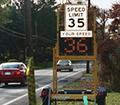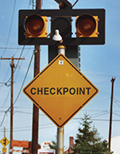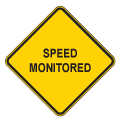Speed limits should be 25 mph in both directions within the ECF area. Roadways through ECFs should not have higher posted speed limits, since vehicles must stop at the ID Check area, and may encounter queuing. Geometry designed for slower speeds reduces the required response zone. Some techniques to encourage motorists to travel at slower speeds are shown below.
| Category |
Application Restrictions |
Installation Requirements |
Benefits |
Graphics |
Other Issues |
| Roadway Curvature |
Not suitable on roadways with an AADT above 10,000
Not suitable on roadways less than 20 feet wide |
Provide transitions into and out of lane narrowing
Maintain at least a 10 feet lane |
Minor speed reduction” “Wider shoulders
Additional separation from bike lanes/sidewalks |
 |
Minimal speed reduction without physical constraints (raised median, curbing, flexible delineator posts, etc)
Maintenance” “Potential reduction in level of service |
Ruble Strips - Milled Style |
Consider use when housing is not adjacent to the ECFPlace far enough in advance so the sound created does not interfere with the guard’s ability to communicateSurface apply rumble strips are not approved; however, embedded rumble strips may be allowed |
Longitudinal width of 7 inches (180 millimeters)Transverse width of 16 inches (400 millimeters)Depth of 0.5 inches (12) millimeters |
Reduces speeds and makes the driver aware of upcoming roadway featuresIn a shoulder application, the PA Turnpike experienced a 70% decrease in run-off-road crashes |
 |
NoiseSnow removalBicycles |
| Ruble Strips - Rolled or Formed Style |
Longitudinal width of 1.5 inches (38 millimeters)Spaced 8 inches (200 millimeters) apartDepth of 1.25 inches (32 millimeters) |
 |
| Speed Humps - Watts Profile Style |
Recommended only for local streets having an ADT of less than 3,500 vehicles and a posted speed limit of 30 mph (48kph) or lessUFC approved for Installation at ECFs |
Longitudinal width of 12 feet (3.6 meters)Height of 3-4 inches (75-100 millimeters) |
6.5-8.0 mph (10.5 -12.9 km/h) speed reduction |
 |
Emergency vehicle response timesDrainageBicyclesProximity to intersectionsGradeCurves |
| Speed Humps - Seminole Style |
Appropriate for streets with an ADT of up to 6,500 vehiclesUFC approved for installation at ECFs |
Longitudinal width of 22 feet (6.7 meters)Height of 3-4 inches (75-100 millimeters) |
6.5-8.0 mph (10.5 -12.9 km/h) speed reduction |
 |
| Textured Pavements |
Not suitable on roadways with speed limits of 45 mph or greater |
Natural colors that do not conflict with the MUTCD should be usedBrick, cobblestone, stamped pavement are styles |
Minor speed reductionImproved aestheticsMay create a minor rumble effect depending on style |
 |
Noise depending on styleTextured style may impact those in wheelchairs, strollers, etc. |
| Speed Warning Systems |
Locate outside clear zone |
Must be MUTCD compliantThe speed warning system should display “YOUR SPEED XX, SAFE SPEED XX” or “YOUR SPEED XX, SPEED LIMIT XX” |
Speed reductionIn Colorado, this system was installed and average speeds were reduced from 66 mph (106 kph) to 45 mph (72 kph) |
 |
Maintenance |
| Roadway Narrowing |
Not suitable on roadways with an AADT above 10,000Not suitable on roadways less than 20 feet wide |
Provide transitions into and out of lane narrowingMaintain at least a 10 feet lane |
Minor speed reduction” “Wider shouldersAdditional separation from bike lanes/sidewalks |
 |
Minimal speed reduction without physical constraints (raised median, curbing, flexible delineator posts, etc)Maintenance” “Potential reduction in level of service |
| Flashing Warning Devices |
Locate outside clear zone |
Must be MUTCD compliant |
Can increase awareness and recognition of ECF features thus encouraging lower speeds |
 |
Maintenance |
| Advanced Speed Detection and Signing - Radar |
None |
Advance speed detection monitors speed of approaching vehicles and notifies guardsIt can be used to detect threats but can also be used to proactively encourage speed reduction |
Guards can warn motorists of speed making enforcement more proactive |
 |
Privacy concernsMaintenanceOperations |
| Advanced Speed Detection and Signing - Photo |
State legislation allowing use |
Advance speed detection monitors speed of approaching vehicles and notifies guardsIt can be used to detect threats but can also be used to proactively encourage speed reduction |
Guards can warn motorists of speed making enforcement more proactiveCan track reoccurring offenders |
 |
Privacy concernsMaintenanceOperations |
